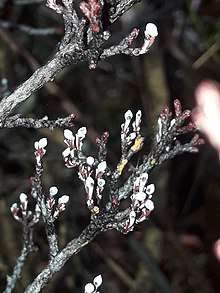Parasitaxus
Parasitaxus ustus is a rare species of conifer of the family Podocarpaceae, and the sole species of the genus Parasitaxus. It is a woody shrub up to 1.8 m found only in the remote, densely forested areas of New Caledonia, first discovered and described by Vieillard in 1861.
| Parasitaxus | |
|---|---|
 | |
| Scientific classification | |
| Kingdom: | Plantae |
| Clade: | Tracheophytes |
| Division: | Pinophyta |
| Class: | Pinopsida |
| Order: | Pinales |
| Family: | Podocarpaceae |
| Genus: | Parasitaxus de Laub. |
| Species: | P. usta |
| Binomial name | |
| Parasitaxus usta (Vieill.) de Laub. | |
| Synonyms | |
| |
It is generally mentioned that Parasitaxus usta is the only known parasitic gymnosperm. The species remarkably lacks roots and is always found attached to the roots of Falcatifolium taxoides (another member of the Podocarpaceae). However, the question is still left open, as the plant is in any case not a haustorial parasite, which is usually the case with angiosperms. Certain experts therefore consider the plant as a myco-heterotroph.
Molecular phylogenetic analysis also suggest affinities between Parasitaxus and the genera Manoao (New Zealand) and Lagarostrobos (Tasmania).[2] Parasitaxus has been shown to contain high levels of chlorophyll. [3] However, a genome analysis shows that many genes for photosynthesis are missing from the parasite's plastid genome [4], strongly suggesting that Parasitaxus completely depends on its host for survival.

The species was first described as Dacrydium ustum Vieill.; other synonyms include Podocarpus ustus (Vieill.) Brongn. & Gris, and Nageia usta (Vieill.) Kuntze. The name is often cited as Parasitaxus ustus, but this is grammatically incorrect, as, according to Latin, the genus name Parasitaxus is (like Taxus) gender-feminine, with which the species name's gender must agree (Nickrent 2006). The scientific name translates as "Burnt Parasitic Yew."
Etymology
Usta means 'parched'.[5]
References
- Thomas, P. (2010). "Parasitaxus usta". The IUCN Red List of Threatened Species. IUCN. 2010: e.T31002A9597883. doi:10.2305/IUCN.UK.2010-3.RLTS.T31002A9597883.en. Retrieved 12 December 2017.
- Sinclair, W. T., R. R. Mill, M. F. Gardner, P. Woltz, T. Jaffré, J. Preston, M. L. Hollingsworth, A. Ponge, and M. Möller. (2002) Evolutionary Relationships of the New Caledonian Heterotrophic Conifer Parasitaxus Ustus (Podocarpaceae), Inferred from Chloroplast trnL-F Intron/Spacer and Nuclear ITS2 Sequences. Plant Systematics and Evolution 233: 79–104.
- Feild, T.S; Brodribb, T.J. (2005). "A unique mode of parasitism in the conifer coral tree Parasitaxus ustus (Podocarpaceae)". Plant Cell Env. 28 (10): 1316–1325. doi:10.1111/j.1365-3040.2005.01378.x.
- Qu, X-J.; Fan, S-J.; Wicke, S.; Yi, T-S. (2019). "Plastome reduction in the only parasitic gymnosperm Parasitaxus is due to losses of photosynthesis but not housekeeping genes and apparently involves the secondary gain of a large inverted repeat". Genome Biology and Evolution. 11 (10): 2789–2796. doi:10.1093/gbe/evz187.
- Gledhill, David (2008). "The Names of Plants". Cambridge University Press. ISBN 9780521866453 (hardback), ISBN 9780521685535 (paperback). pp 395
